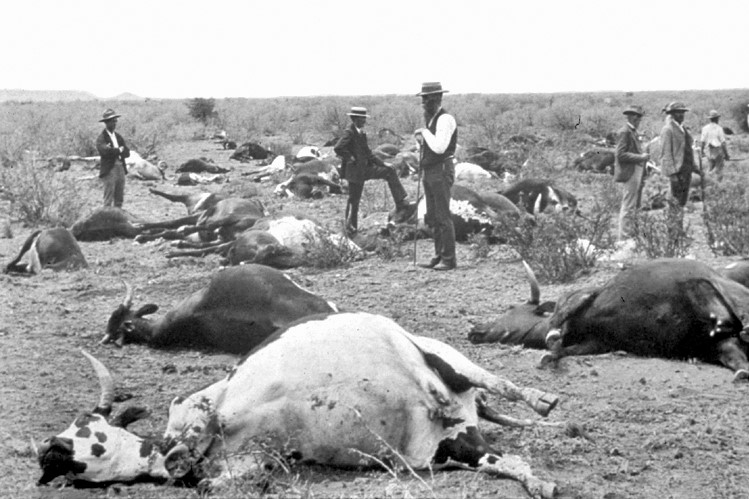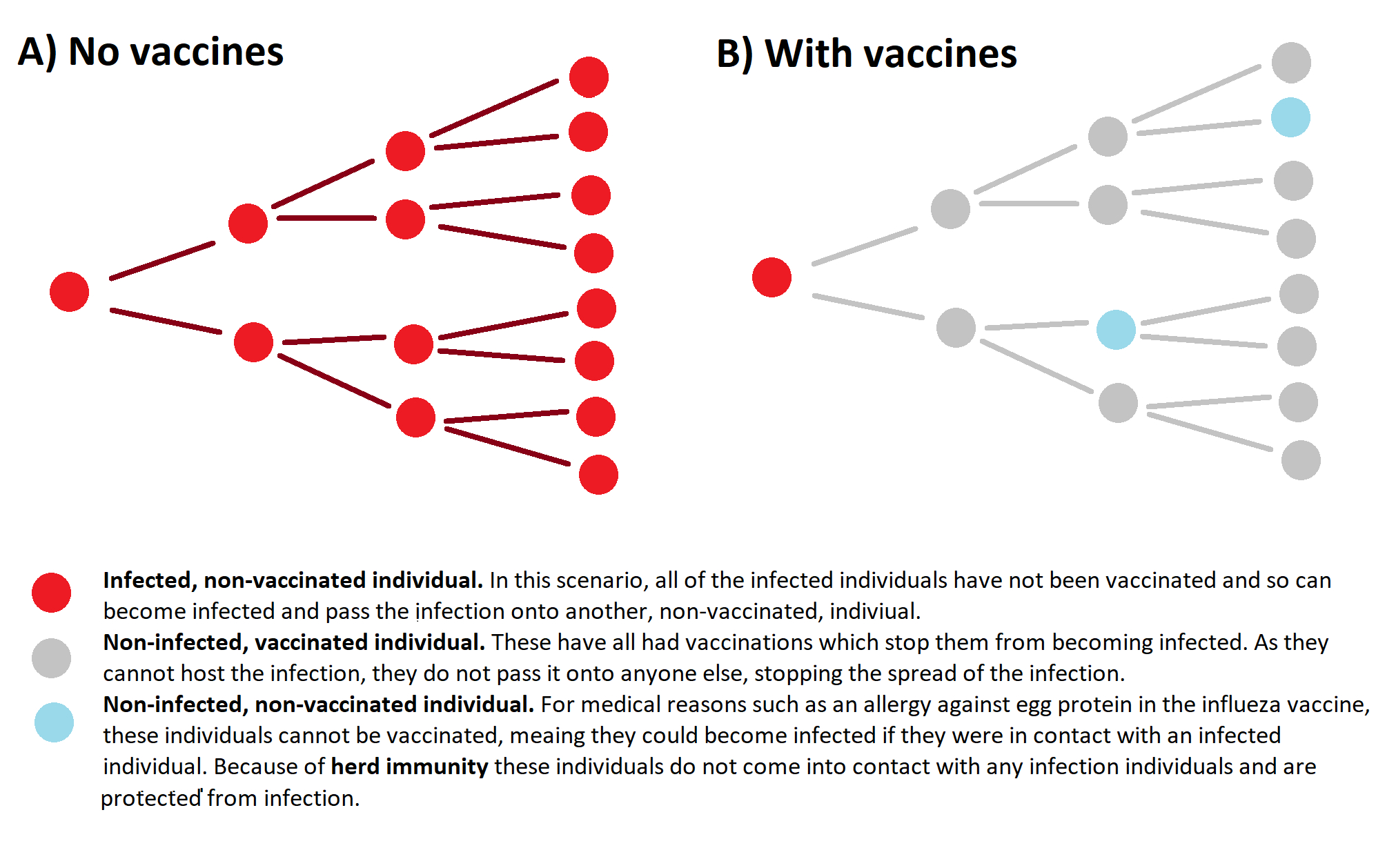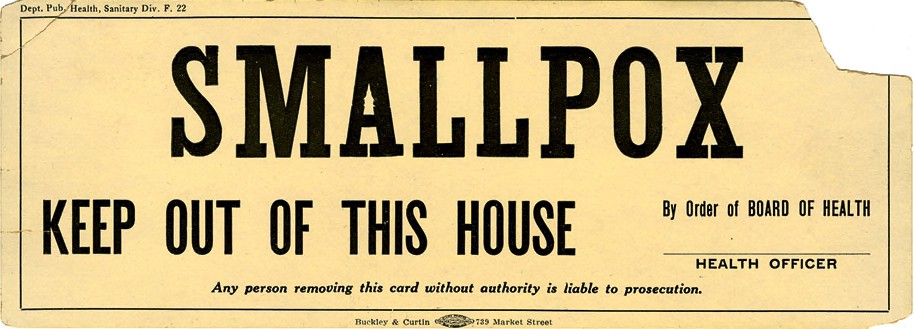This topic takes on average 55 minutes to read.
There are a number of interactive features in this resource:
 Science
Science
 Biology
Biology
Vaccines are an effective tool in preventing the spread of diseases in animal populations, maintaining animal health, and preventing transmission of zoonotic diseases to humans.
Animals that produce beef, dairy and lamb products are protected from a range of endemic (e.g. a disease naturally occurring in the UK) and exotic diseases by vaccinations. There is a constant threat to livestock from bacteria which live in soil, e.g. Clostridial diseases. An infection with one of these diseases is often fatal, so cattle thought to be at risk are vaccinated to protect them from infection. Other farm animals, such as pigs and chickens, can also be vaccinated to protect them from a range of deadly infections1. Vaccines also play a huge role in preventing many different types of respiratory diseases, e.g. influenza or “flu” in many different species.
Vaccines prevent disease spread and reduce the need for treatment with antibiotics as a result of bacterial infection. In this way, vaccines also help to reduce the use of prophylactic medicines. Prophylactic medicines are used to prevent disease – when vaccines can take this role instead of medicines, they are very effective, as they provide immunity to future infections.
Vaccines help prevent the spread of antimicrobial resistance by preventing opportunistic bacterial infections. Opportunistic infections are caused by pathogens that take advantage of a host with a weakened immune system, for example, if they were infected previously with a viral pathogen. These opportunistic bacterial infections would need to be treated with an antibiotic, but vaccines help to prevent this2.
Domestic animals such as cattle, sheep, dogs and goats can be hosts to many of the same virus types as humans, meaning these diseases may be able to infect humans if there are no control methods in place (e.g. vaccines or antibiotics)3. Salmonella are bacteria that can be present in some foodstuffs (e.g. undercooked chicken eggs), and infection can result in diarrhoea, vomiting, nausea, fever, and stomach pain. In 1993 there was an epidemic of Salmonella infections in the UK, but mass poultry vaccinations (amongst other control measures including strict hygiene improvements) have led to a dramatic fall in the number of cases1. This example is an excellent representation of how vaccines can protect and improve public health.
Animal diseases can impact human health indirectly. Vaccination played a central role in the successful worldwide eradication of a disease of cattle called rinderpest in 2011. The rinderpest virus does not cause human disease, yet it is still linked to human health. Before the eradication of rinderpest in 2011, the disease was responsible for a huge number of human deaths and loss of quality of life because of agricultural losses. This was especially the case in developing countries where subsistence agriculture is essential to human well-being. The disease would spread rapidly in a cattle herd and result in a devastating number of deaths of infected animals. Many people relied on these animals for food (milk or beef), and such huge losses resulted in widespread famine.

All vaccines that are licensed to be used in the UK must meet strict regulatory requirements overseen by an independent regulatory authority, the Veterinary Medicines Directorate (VMD). Vaccines train the animal’s own immune system to fight off disease, and they pose no risk to human health4. The National Office for Animal Health has more information about the vaccination of farm animals, here.
Just as farm animals need vaccinating to protect them catching often fatal diseases, companion animals such as dogs and cats need vaccinations too. The development of companion animal vaccines has dramatically improved the health and welfare of pets, preventing serious life-threatening illnesses from infecting our pets.
| Table 2. Examples of diseases controlled by vaccines in companion animals in the UK2 | |
| Species | Diseases controlled by vaccines |
|---|---|
| Dogs | Distemper, infectious canine hepatitis, leptospirosis, parvovirus, kennel cough, rabies |
| Cats | Feline leukaemia, chlamydia, cat ‘flu’(feline herpes virus and feline calicivirus), rabies |
| Horses | Equine herpes virus 1, influenza, tetanus, viral arteritis, rabies |
| Rabbits | Myxomatosis, viral haemorrhagic disease |
It is thought that increasing human contact with wild animal populations is part of the current increase in the emergence of infectious diseases, such as Ebola and Covid-193. Wild animals that have adapted to live well alongside humans, such as rats, foxes, and primates, have been identified as host organisms for nearly 75% of viruses3. Wild species which typically have limited contact with human populations are also capable of transmitting diseases to humans, especially where natural habitats have been disrupted and reduced in size by human activity.
To prevent the spread of diseases from wild populations, using a combination of tools from different sectors is important. Some of the techniques used to control diseases in wild animals are:
For vaccinations to protect every member of a community, herd immunity is important. Herd immunity occurs when a high percentage of the population is vaccinated and is resistant to the spread of a contagious disease because of this. In this instance, it is hard for an infectious disease to spread, because there are few susceptible host organisms for the disease to infect. This can help protect individuals that cannot be vaccinated, because they are too young, or allergic to a vaccine component (egg proteins in Influenza vaccine, for example).

Vaccines have been described as a ‘victim of their own success’. The success of vaccines in preventing fatal diseases has led to generations of people not experiencing the regular and sometimes devastating disease outbreaks common in previous centuries. When individuals do not experience disease outbreaks, myths surrounding vaccines can spread, and individuals are falsely led to believe that vaccines are more of a risk than contracting the disease the vaccine protects against. Vaccine hesitancy has been named by the World Health Organisation (WHO) as one of the top 10 health threats of 20195.
Opposition to vaccines has been around for centuries. In 1772, an English Reverend referred to vaccines as ‘diabolical operations’. Lack of knowledge and understanding around the causes of sickness meant that infectious diseases were often considered a punishment from God for sin, and vaccines were considered ‘an attempt to oppose God’s punishments upon man for his sins’6.

More recently, anti-vaccine actions included a paper published in 1998 by a now discredited British doctor and researcher. In this paper, which has since been removed from publication, the measles, mumps, and rubella (MMR) vaccine was incorrectly linked to the development of autism in young children6. Even with the removal of the paper from publication and other scientific studies disproving a link between this vaccine and autism, the damage had been done. This myth spread to many different parts of the world, resulting in a drop in the number of children getting the MMR vaccination. In the UK for example, vaccination rates dropped from 92% in 1996 to 84% in 2002 – as measles is a highly infectious disease, a 95% vaccination rate is necessary for herd immunity to protect those in our communities who cannot be vaccinated7. This has resulted in several breakouts of measles occurring throughout the world.
In 2019, 1282 cases of measles were reported in the United States, with 128 individuals having to be hospitalised and 61 reporting complications such as pneumonia (inflammation of the tissue in one or both lungs) or encephalitis (inflammation of brain tissue). This was the largest number of cases in the US since 1992. Most people infected had not been vaccinated8. Measles cases in the UK increased sharply in 2018 as a result of teenagers catching the disease who had not been vaccinated when they were younger.
Healthy animals are important for preventing spread of diseases to human populations and making sure there is enough food to feed our population. Vaccine hesitancy impacts the health of animal populations as well. As animal owners no longer see many of the preventable diseases in their animals, some may feel it is an unnecessary cost to protect their pet using vaccines. However, these vaccine preventable diseases have not been eradicated and still pose a serious risk to pets.
Vaccines protect people and animals from many serious and potentially deadly diseases, such as smallpox, polio, and tetanus, which used to kill or disable millions of people. It is necessary to have a high proportion of a population vaccinated to protect those who cannot be vaccinated against a certain disease. Vaccines are safety tested for years before they are authorised by independent scientific regulatory authorities, for use. Any side effects (e.g. swelling at the site of infection, mild fever, headache) typically pass quickly and are a result of the body’s immune system learning to fight off the infection, so it can respond more quickly if it encounters the live pathogen in the future9. Furthermore, the independent scientific regulatory authorities for both human and veterinary medicines monitor reports of any side effects and keep the safety of the products under continuous review and scrutiny, a process known as pharmacovigilance.